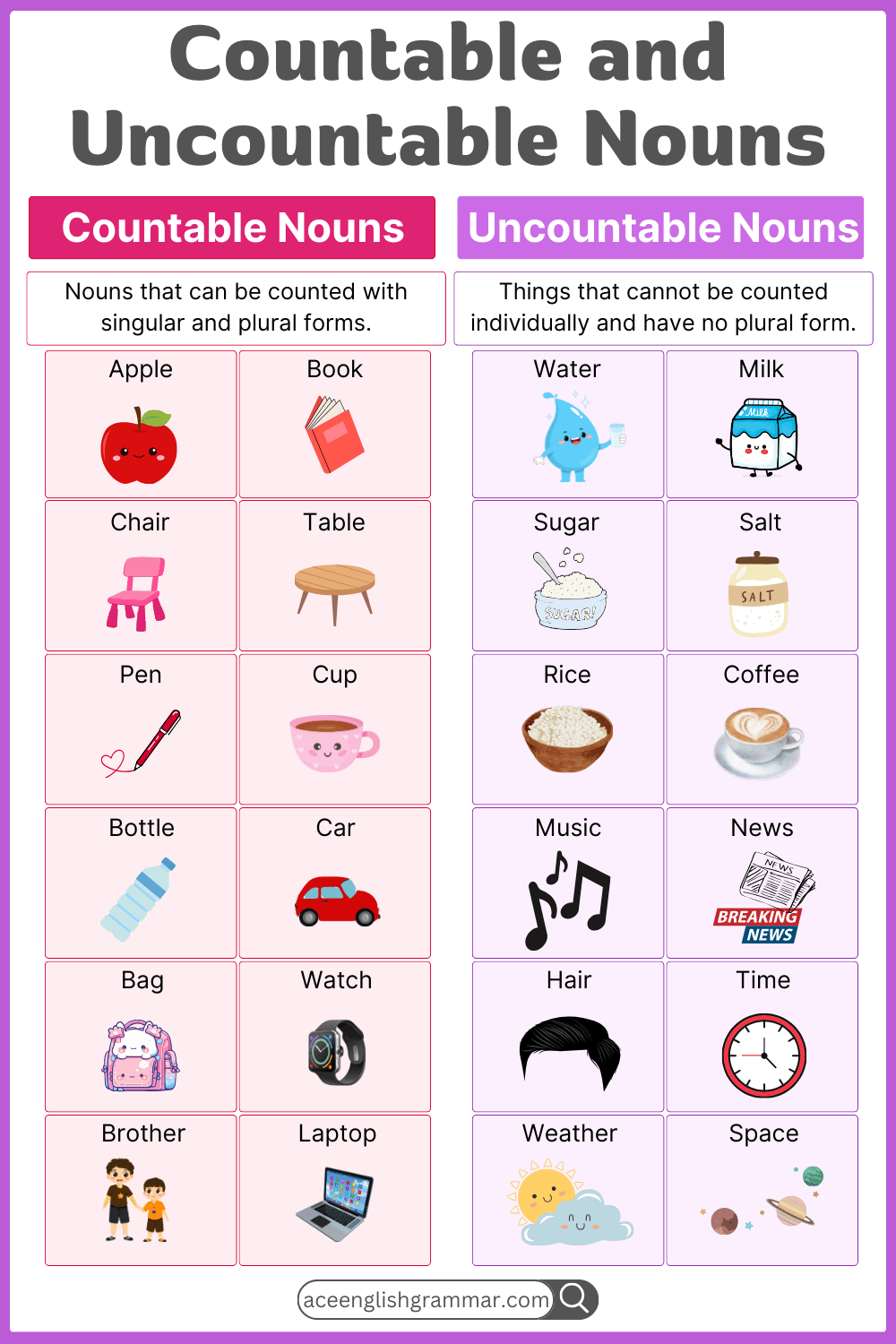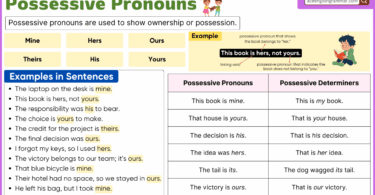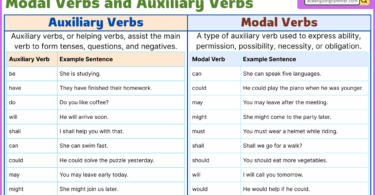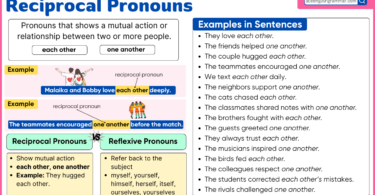Nouns in English are divided into countable and uncountable types, influencing how they are used in sentences. Countable nouns refer to objects that can be counted, while uncountable nouns represent things that cannot be individually counted. Recognizing the difference between them is essential for mastering English grammar. This guide covers their definitions, rules, examples, and common mistakes to avoid.
Table of Contents
What is a Countable Noun?
A countable noun is a noun that refers to objects, people, or concepts that can be counted as individual units. These nouns have both singular and plural forms and can be used with numbers and articles like a/an and the.
- I have a book on my desk.
- She bought three apples from the market.
In these sentences, “book” and “apples” can be counted, making them countable nouns.

Rules for Using Countable Nouns
- Use singular or plural forms:
- Singular: a pen, an orange
- Plural: pens, oranges
- Use numbers before countable nouns:
- She has two bags.
- Use “many” instead of “much”:
- There is much chairs in the room. ❌
- There are many chairs in the room. ✅
List of Countable Nouns
The table below shows singular and plural forms of common countable nouns:
| Singular | Plural |
|---|---|
| Chair | Chairs |
| Table | Tables |
| Book | Books |
| Car | Cars |
| Apple | Apples |
| Dog | Dogs |
| Pen | Pens |
| Shirt | Shirts |
| Bottle | Bottles |
| Computer | Computers |
| Window | Windows |
| Student | Students |
| House | Houses |
| Bag | Bags |
| Phone | Phones |
| Friend | Friends |
| Teacher | Teachers |
| Cup | Cups |
| Hat | Hats |
| Lamp | Lamps |
| Key | Keys |
| Spoon | Spoons |
| Ball | Balls |
| Doll | Dolls |
| Ticket | Tickets |
| Pillow | Pillows |
| Watch | Watches |
| Door | Doors |
| Tree | Trees |
| Shirt | Shirts |
What is an Uncountable Noun?
An uncountable noun refers to substances, concepts, or abstract things that cannot be counted individually. These nouns do not have a plural form and are used with singular verbs.
Example:
- There is water in the bottle.
- He has a lot of knowledge about history.
Here, “water” and “knowledge” cannot be counted separately, making them uncountable nouns.
Rules for Using Uncountable Nouns
- Do not use “a” or “an”:
- I need a water. ❌
- I need some water. ✅
- Use “much” instead of “many”:
- There are many sugar in the jar. ❌
- There is much sugar in the jar. ✅
- Use singular verbs with uncountable nouns:
- The furniture are new. ❌
- The furniture is new. ✅
Examples of Uncountable Nouns
A list of uncountable nouns includes words for things that cannot be counted individually, such as substances, abstract ideas, or collective categories. They have no plural form and require measurement words for quantification.
| Uncountable Nouns | Uncountable Nouns |
|---|---|
| Water | Music |
| Milk | Happiness |
| Rice | Traffic |
| Salt | Education |
| Sugar | News |
| Information | Bread |
| Advice | Coffee |
| Knowledge | Gold |
| Furniture | Silver |
| Luggage | Money |
| Equipment | Energy |
| Air | Health |
| Work | Progress |
| Research | Weather |
| Love | Courage |
Difference Between Countable and Uncountable Nouns
| Feature | Countable Nouns | Uncountable Nouns |
| Can be counted? | Yes | No |
| Plural form? | Yes | No |
| Used with numbers? | Yes (one, two, etc.) | No |
| Articles used? | A/An, The | The (no A/An) |
| Example | Chair, apple | Water, sugar |
Common Mistakes to Avoid
- ❌ Incorrect: He gave me an advice.
- ✅ Correct: He gave me some advice.
- ❌ Incorrect: The furnitures are expensive.
- ✅ Correct: The furniture is expensive.
- ❌ Incorrect: She bought two breads.
- ✅ Correct: She bought two loaves of bread.
FAQs
Countable nouns are things we can count, like “books” and “chairs.” Uncountable nouns cannot be counted separately, like “water” and “sugar.” Countable nouns have singular and plural forms, while uncountable nouns do not.
Countable nouns have plural forms (book → books).
Uncountable nouns do not have plural forms (water, furniture).
Countable nouns can use a/an (a table), but uncountable nouns cannot.
Yes, sometimes. When referring to a specific type or unit, some uncountable nouns can act as countable nouns. For example:
“Coffee” (uncountable) → “A coffee” (one cup of coffee)
“Paper” (uncountable) → “A paper” (a newspaper)
Use words like some, a lot of, much, a piece of, a bottle of for uncountable nouns. For example:
Some water (not “a water”)
A piece of advice (not “an advice”)
Uncountable nouns refer to things that are not separate objects, like liquids, ideas, and substances. Since they cannot be divided into individual units, they remain singular.
Download PDF
Understanding the difference between countable and uncountable nouns is essential for proper English usage. To help you learn easily, we have created a PDF guide that includes definitions, key differences, and examples of both types of nouns.
Conclusion
Understanding the difference between countable and uncountable nouns is essential for proper English grammar. Countable nouns can be counted, have singular and plural forms, and are used with numbers and articles like a/an. Uncountable nouns refer to things that cannot be counted individually, requiring singular verbs and special quantifiers like some, much, or a lot of. By following the rules and avoiding common mistakes, learners can use these nouns correctly in everyday communication.
Read More



